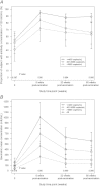Immunogenicity, immunologic memory, and safety following measles revaccination in HIV-infected children receiving highly active antiretroviral therapy
- PMID: 22693229
- PMCID: PMC3491735
- DOI: 10.1093/infdis/jis386
Immunogenicity, immunologic memory, and safety following measles revaccination in HIV-infected children receiving highly active antiretroviral therapy
Abstract
Background: Response rates and immunologic memory following measles vaccination are reduced in human immunodeficiency virus (HIV)-infected children in the absence of highly active antiretroviral therapy (HAART).
Methods: HIV-infected children 2 to <19 years old receiving HAART and with HIV loads <30,000 copies/mL, CD4% ≥15, and ≥1 prior measles-mumps-rubella vaccination (MMR) were given another MMR. Measles antibody concentrations before and 8, 32, and 80 weeks postvaccination were determined by plaque reduction neutralization (PRN). A subset was given another MMR 4-5 years later, and PRN antibody was measured before and 7 and 28 days later.
Results: At entry, 52% of 193 subjects were seroprotected (PRN ≥120 mIU/mL). Seroprotection increased to 89% 8 weeks postvaccination, and remained at 80% 80 weeks postvaccination. Of 65 subjects revaccinated 4-5 years later, 85% demonstrated memory based on seroprotection before or 7 days after vaccination. HIV load ≤400 copies/mL at initial study vaccination was associated with higher seroprotection rates, greater antibody concentrations, and memory. Grade 3 fever or fatigue occurred in 2% of subjects.
Conclusions: Measles revaccination induced high rates of seroprotection and memory in children receiving HAART. Both endpoints were associated with HIV viral load suppression.
Clinical trials registration: NCT00013871 (www.clinicaltrials.gov).
Figures




Comment in
-
Measles vaccine, HIV infection, and antiretroviral therapy--a window of opportunity.J Infect Dis. 2012 Aug 15;206(4):466-8. doi: 10.1093/infdis/jis392. Epub 2012 Jun 12. J Infect Dis. 2012. PMID: 22693235 No abstract available.
References
-
- Kaplan LJ, Daum RS, Smaron M, McCarthy CA. Severe measles in immunocompromised patients. JAMA. 1992;267:1237–41. - PubMed
-
- Krasinski K, Borkowsky W. Measles and measles immunity in children infected with human immunodeficiency virus. JAMA. 1989;261:2512–6. - PubMed
-
- Palumbo P, Hoyt L, Demasio K, Oleske J, Connor E. Population-based study of measles and measles immunization in human immunodeficiency virus-infected children. Pediatr Infect Dis J. 1992;11:1008–14. - PubMed
-
- Al-Attar I, Reisman J, Muehlmann M, McIntosh K. Decline of measles antibody titers after immunization in human immunodeficiency virus-infected children. Pediatr Infect Dis J. 1995;14:149–51. - PubMed
-
- Arpadi SM, Markowitz LE, Baughman AL, et al. Measles antibody in vaccinated human immunodeficiency virus type 1-infected children. Pediatrics. 1996;97:653–7. - PubMed
Publication types
MeSH terms
Substances
Associated data
Grants and funding
LinkOut - more resources
Full Text Sources
Medical
Research Materials

